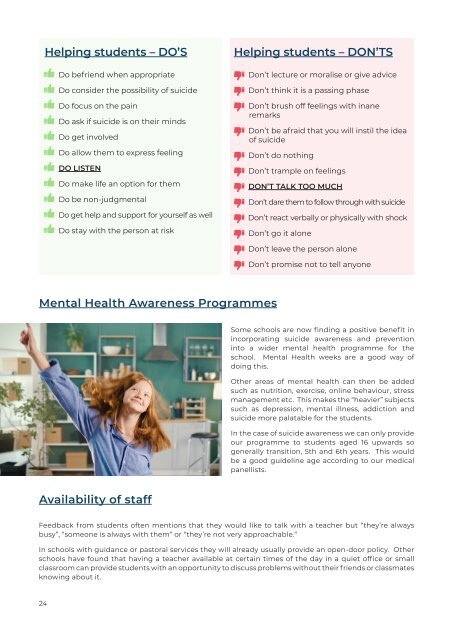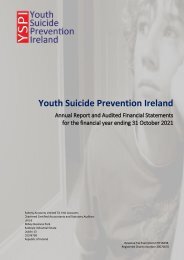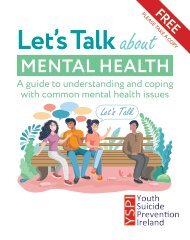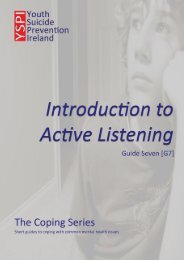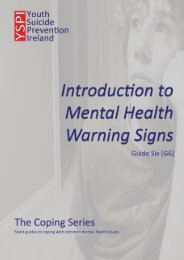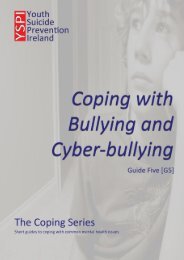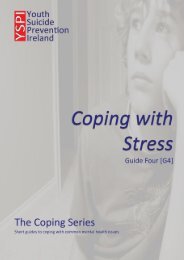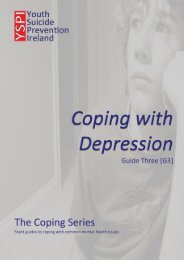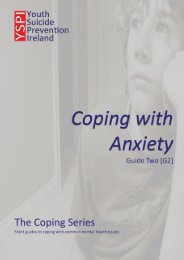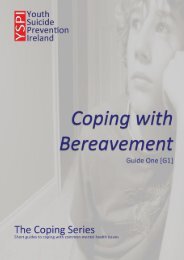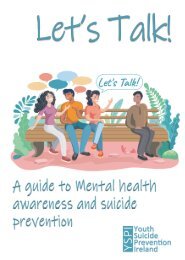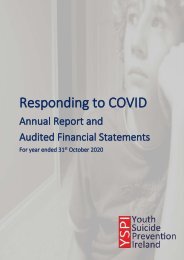Guidance and Information for Teachers and Lecturers
Teachers' guide to youth mental health and suicide prevention, now in it's 10th edition. Topics covered in this guide include: * Introduction to youth mental health awareness * Awareness of mental health risk factors * Recognising the symptoms of mental health issues * Helping someone with mental health issues * Understanding the dangers: Cyber-bullying Online Dangers Locked-away Syndrome * Supporting and developing coping strategies * Warnings signs of suicidal thoughts * Suicide Prevention and intervention * How to help and get help * Child Protection Policies
Teachers' guide to youth mental health and suicide prevention, now in it's 10th edition.
Topics covered in this guide include:
* Introduction to youth mental health awareness
* Awareness of mental health risk factors
* Recognising the symptoms of mental health issues
* Helping someone with mental health issues
* Understanding the dangers:
Cyber-bullying
Online Dangers
Locked-away Syndrome
* Supporting and developing coping strategies
* Warnings signs of suicidal thoughts
* Suicide Prevention and intervention
* How to help and get help
* Child Protection Policies
- No tags were found...
You also want an ePaper? Increase the reach of your titles
YUMPU automatically turns print PDFs into web optimized ePapers that Google loves.
Helping students – DO’S<br />
Do befriend when appropriate<br />
Do consider the possibility of suicide<br />
Do focus on the pain<br />
Do ask if suicide is on their minds<br />
Do get involved<br />
Do allow them to express feeling<br />
DO LISTEN<br />
Do make life an option <strong>for</strong> them<br />
Do be non-judgmental<br />
Do get help <strong>and</strong> support <strong>for</strong> yourself as well<br />
Do stay with the person at risk<br />
Helping students – DON’TS<br />
Don’t lecture or moralise or give advice<br />
Don’t think it is a passing phase<br />
Don’t brush off feelings with inane<br />
remarks<br />
Don’t be afraid that you will instil the idea<br />
of suicide<br />
Don’t do nothing<br />
Don’t trample on feelings<br />
DON’T TALK TOO MUCH<br />
Don’t dare them to follow through with suicide<br />
Don’t react verbally or physically with shock<br />
Don’t go it alone<br />
Don’t leave the person alone<br />
Don’t promise not to tell anyone<br />
Mental Health Awareness Programmes<br />
Some schools are now finding a positive benefit in<br />
incorporating suicide awareness <strong>and</strong> prevention<br />
into a wider mental health programme <strong>for</strong> the<br />
school. Mental Health weeks are a good way of<br />
doing this.<br />
Other areas of mental health can then be added<br />
such as nutrition, exercise, online behaviour, stress<br />
management etc. This makes the “heavier” subjects<br />
such as depression, mental illness, addiction <strong>and</strong><br />
suicide more palatable <strong>for</strong> the students.<br />
In the case of suicide awareness we can only provide<br />
our programme to students aged 16 upwards so<br />
generally transition, 5th <strong>and</strong> 6th years. This would<br />
be a good guideline age according to our medical<br />
panellists.<br />
Availability of staff<br />
Feedback from students often mentions that they would like to talk with a teacher but “they’re always<br />
busy”, “someone is always with them” or “they’re not very approachable.”<br />
In schools with guidance or pastoral services they will already usually provide an open-door policy. Other<br />
schools have found that having a teacher available at certain times of the day in a quiet office or small<br />
classroom can provide students with an opportunity to discuss problems without their friends or classmates<br />
knowing about it.<br />
24


